

The Search Is On For Antimony Deposits In Atlantic Canada. World equity markets are soaring to multi-year highs not seen since before the 2008 credit crisis.

China is rebounding, Japan is recovering, U.S. Housing and financials have had a major rally in 2012. These major accommodative actions from Central Banks since the 2008 credit and housing crisis has helped boost an economy which was on the brink of failure. Central Bankers around the world have chosen an inflationary scenario. While the general and world markets are hitting new highs, I am still seeing bargain opportunities in the strategic and industrial metal miners.
The strategic mining sector may attract the attention of industrial end users who are seeing their stock valuations hit new highs. American Resources Policy NetworkAmerican Resources Policy Network. In a piece for DailyMarkets.com, analyst Jeb Handwerger zeroes in on Antimony.

Antimony is a key component in fire retardants as well as batteries, ceramics, touch-screen technology, glass, and ammunition and has seen largely stable prices in unstable economic times. With China being its top producer controlling nearly 90 percent of global supply and other lead producers not necessarily classifying as “mining friendly jurisdictions,” it comes as no surprise that the British Geological Survey (BGS) ranked Antimony as the “main metal at risk of a supply shortfall” on its 2011 Risk List. One of the developments that has drawn Handwerger’s attention is the closure of the (Chinese-owned) Beaver Brook Antimony Mine – the only North American Antimony-producing mine.
Handwerger does see potential in Atlantic Canada, and discusses this potential, as well as the closure of the Beaver Brook Antimony Mine, and China’s role in a video. WGI: World Governance Index. You can see here the 2011 Report: * The main article (English) (Français) (Español) (中文)* The WGI document (English) (Français)* The WGI Map (English) (Français) (Español) (中文) Developing a new world governance constitutes one of the major challenges of our times, perhaps the most important of all.
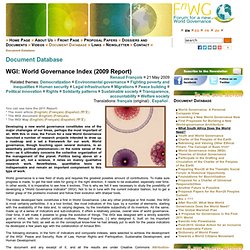
With this in view, the Forum for a new World Governance launched a number of research projects intended to draw up a roadmap and a set a framework for our work. World governance, though touching upon several domains, is an essentially political phenomenon—in the noble sense of the term—as it ultimately concerns the collective organization of the management of the planet. Politics being above all a practical art, not a science, it relies on mainly qualitative research work. Nevertheless, quantitative tools are indispensable and remain an important complement to this type of work. World Governance Index. The World Governance Index (WGI) is an indicator developed in 2008 by the Forum for a new World Governance (FnWG).
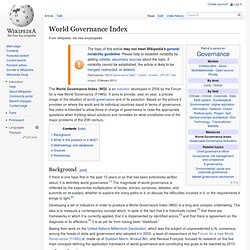
It aims to provide, year on year, a precise image of the situation of world governance and of its evolution. Based on the picture it provides on where the world and its individual countries stand in terms of governance, this index is intended to allow those in charge of governance to raise the appropriate questions when thinking about solutions and remedies for what constitutes one of the major problems of the 20th century.
Background[edit] If there is one topic that in the past 15 years or so that has been extensively written about, it is definitely world governance.[1] The magnitude of world governance is reflected by the exponential multiplication of books, articles, symposia, debates, and summits on its subject, whether to explore the many paths to it, to discuss the difficulties involved in it, or the requirements it brings to light.[2] Results for raw materials. Materials and energy : a story of linkages. Interview: Putting the Chinese-Japanese island dispute into perspective. Le graphène pourrait enfin entrer scène.
Depuis des années déjà, le graphène, un cristal de carbone dont l’empilement constitue le graphite, est promis à un très brillant avenir dans nos technologies. Facile à produire, très efficace, il devait être présent dans tous nos gadgets. Malheureusement, il s’est révélé bien trop difficile à manipuler. Mais il pourrait bien enfin trouver sa place grâce à un nouveau procédé. Des chercheurs de l’Université Norvégienne de Sciences et Technologie ont mis au point un tout nouveau procédé pour créer des semi-conducteurs sur du graphène . Une commercialisation pourrait même être possible dans les cinq années à venir. Ensuite, en ajoutant de l’arsenic, celui-ci pénètre dans les gouttelettes et les cristallise par le bas, formant ainsi une tige.
D’après les chercheurs en charge du projet, un tel matériau pourrait être utilisée dans ces cellules solaires flexibles ou comme diodes lumineuses. Focus sur le procédé de recyclage des terres rares issues d'ampoules basse conso hors d'usage. Avec l'instauration de quotas chinois à l'exportation de terres rares, l'approvisionnement pour les industries occidentales de haute technologie devient problématique.
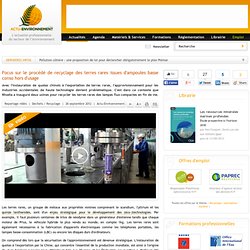
C'est dans ce contexte que Rhodia a inauguré deux usines pour recycler les terres rares des lampes fluo compactes en fin de vie. Les terres rares, un groupe de métaux aux propriétés voisines comprenant le scandium, l'yttrium et les quinze lanthanides, sont d'un enjeu stratégique pour le développement des (éco-)technologies. Par exemple, il faut plusieurs centaines de kilos de néodyme dans un générateur d'éolienne tandis que chaque moteur de Prius, le véhicule hybride le plus vendu au monde, en compte 1kg. Audit ressources rares. Vous souhaitez évaluer la dépendance de votre supply chain à l'approvisionnement en ressources rares?
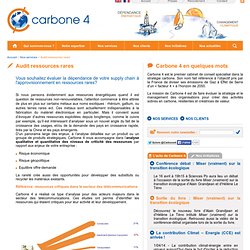
Si nous pensons évidemment aux ressources énergétiques quand il est question de ressources non-renouvelables, l’attention commence à être attirée de plus en plus sur certains métaux aux noms exotiques : rhénium, gallium, ou autres terres rares ect. European Innovation Partnership on Raw Materials - Raw materials - Enterprise and Industry. The supply of raw materials, the lifeblood of today's high-tech industry, is increasingly under pressure.
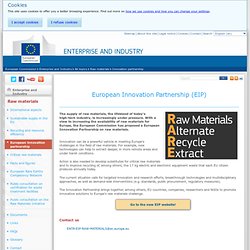
With a view to increasing the availability of raw materials for Europe, the European Commission has proposed a European Innovation Partnership on raw materials. Innovation can be a powerful vehicle in meeting Europe's challenges in the field of raw materials. For example, new technologies can help to extract deeper, in more remote areas and under harsh conditions. Action is also needed to develop substitutes for critical raw materials and to improve recycling of, among others, the 17 kg electric and electronic equipment waste that each EU citizen produces annually today. The current situation calls for targeted innovation and research efforts, breakthrough technologies and multidisciplinary approaches, as well as demand-side interventions (e.g. standards, public procurement, regulatory measures).
Les matériaux de demain. Valorisation des ressources marines : accord-cadre entre l'Ifremer et le Gouvernement de Nouvelle-Calédonie. Electrolytic Manganese Supply Risk For U.S. – Part Two. Continued from Part One.
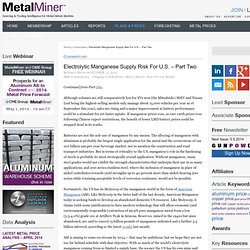
Although volumes are still comparatively low for EVs now (the Mitsubishi i MiEV and Nissan Leaf being the highest-selling models only manage about 15,000 vehicles per year as of September this year), sales are rising and a major improvement in battery performance could be a stimulant for yet faster uptake. If manganese prices rose, as rare earth prices rose following Chinese export restrictions, the benefit of lower LMD battery prices could be stopped dead in its tracks. Batteries are not the sole use of manganese by any means. The alloying of manganese with aluminum is probably the largest single application for the metal and the cornerstone of our 100 billion can-per-year beverage market, not to mention the construction and road transport industries.
But in terms of criticality to the US, manganese’s role in the hardening of steels is probably its most strategically crucial application. U.S. Facing Supply Risk for Electrolytic Manganese Metal – Part One. We are all well aware of China’s stranglehold on the rare earth metals market, that they produce some 98 percent of global supply and how prices have quadrupled since Beijing began closing illegal mines and restricting exports in the name of environmental protection.
Part and parcel of the furor around the US’ “at-risk position regarding rare earth metals, firms like Lynas and Molycorp have found a much more receptive investor environment for their fund raising, enabling Molycorp to fast-track mine and processing development not to mention use some of those dollars raised to diversify into investments overseas. Well, guess what?
The US isn’t only at risk on rare earths. An interview in Mineweb with Peter Zhang, a Vancouver-based consultant with extensive experience in China and the US, details a potentially even greater risk for US steel and metals companies due to supply constraints of manganese. To be continued in Part Two tomorrow morning. Two of a kind? Manganese and Rare Earths. In a new piece on her website, MetalMiner co-founder and American Resources expert Lisa Reisman asks if Manganese is the “Twin Brother or Ugly Stepchild of the Rare Earth Metal Family.” Indeed, there are a number of similarities between both metal markets, which Reisman lists as follows: · Both share significant supply constraints, forcing sourcing managers to devise supply- and commodity risk management strategies. · Both come primarily from China. · Both have seen price drops as a result of restrictive public policies. CEO of junior miner American Manganese Larry Reaugh’s conclusion (based on a study conducted by the CPM Group) that China may well become a net importer of Manganese by 2018 as shutdowns for smaller plants along with other factors will drive cost up, also sounds familiar to those keeping a close eye on the Rare Earths.
Some in Congress have received the message – but whether this will result in actual policy changes remains to be seen. How U.S. Surrendered Manufacturing Base to China. FOCUS-Indian steel trade rely on bourses to manage price risk. Fri Jun 11, 2010 2:07pm IST MUMBAI, June 11 (Reuters) - Increasing volatility in steel prices has prompted smaller makers as well as consumers of the alloy to resort to hedging their price risk on the domestic commodities bourse, company and exchange officials say.
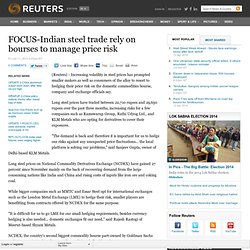
Long steel prices have traded between 22,710 rupees and 29,650 rupees over the past three months, increasing risks for a few companies such as Ramswarup Group, Rathi Udyog Ltd., and KLM Metals who are opting for derivatives to cover their exposures. "The demand is back and therefore it is important for us to hedge our risks against any unexpected price fluctuations... the local platform is solving our problems," said Sanjeev Gupta, owner of Delhi-based KLM Metals. Long steel prices on National Commodity Derivatives Exchange (NCDEX) have gained 27 percent since November mainly on the back of recovering demand from the large consuming nations like India and China and rising costs of inputs like iron ore and coking coal. Indicateur - En mars 2012, les prix des matières premières importées se stabilisent.
En mars, le prix du pétrole en dollars a continué de progresser (+5,3 % après +6,1 % en février). Il s’est établi à 124,5 $ le baril de Brent. 04/05 > BE Israël 77 > De nouveaux matériaux pour la protection balistique. Minerais de molybdène. Les principaux minéraux contenant du molybdène sont la molybdénite (MoS2), la wulfénite (PbMoO4), la molybdite (FeO3 , 3MoO3 + H2O), la powellite [Ca(Mo, W) O4] et quelques autres minerais qui sont sans intérêt économique. La molybdénite est le minéral le plus répandu, vient ensuite la wulfénite ; la powellite n’existe qu’en faible quantité, elle est parfois associée à la scheelite (CaWO4). Actuellement, seule la molybdénite est exploitée ; dans le passé, la wulfénite a contribué à une production substantielle de molybdène. Le molybdène est séparé des minerais de scheelite qui contiennent de la powellite au cours de la préparation de l’acide tungstique, mais ne représente qu’une fraction négligeable de la production.
La molybdénite est disséminée dans des porphyres granitiques et dans des porphyres cuprifères. La minéralisation s’est effectuée par un processus hydrothermal, à des périodes géologiques différentes pour le molybdène et le cuivre. Forages exploratoires : la valse-hésitation du gouvernement. 05/31 > BE France 270 > D'étonnantes nano-fibres plastiques fortement conductrices. Products - Automotive Engineering International Online. Forums GIFAS. Détail d'un texte. Code minier. Allez au contenu, Allez à la navigation.

Www.senat.fr/leg/etudes-impact/pjl11-519-ei/pjl11-519-ei.pdf. Www.developpement-durable.gouv.fr/IMG/pdf/Rapport_d_Arnaud_GOSSEMENT.pdf.
Terres Rares. German Raw Materials Alliance. Circular economy. Recycling. Raw Materials Economics. General Data. EDF. Materials. Acteurs. Notification: Défaillance DNS.